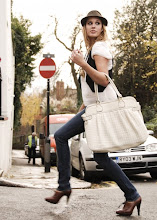
In 1993 the British Fashion Council set up a scheme that, today, is considered by young designers and label heads alike, as one of the most influential stepping-stones into the fashion industry. The New Generation project – or NEWGEN – was the first of its kind to actively seek out and support emerging designer talent. 16 years later and the project has nurtured a host of famous names, whose career might not have been nearly as successful without the guidance and sponsorship that NEWGEN offered.
Sponsored designers fall into three categories – Catwalk, Presentation and Exhibition. Recipients of this sponsorship will then be given all the necessary tools to show their designs at London Fashion Week in the forthcoming season – in this case, SS10 later this month. NEWGEN acts as a promotional launch pad for these talented designers; who range from the newly graduated, to those with years of experience, yet still in need of a break.
It’s undeniable that the media profile built around the scheme is one of the strongest means to attract investment and orders, and whilst the monetary value of each sponsorship can range from between £5,000 to £10,000, it is the guidance and support offered to the NEWGEN scholars that holds the most significant importance.
The BFC won’t immediately back out after one season either. They recognise the support that young designers need at this stage in their career and can award sponsorship to the same designer for up to four seasons. It’s a refreshing approach. Especially compared to those with the sole objective of churning out new apprentices season after season.
In 2001, Topshop became sole sponsors of NEWGEN and have had a proactive involvement in it ever since. By providing show venues and commissioning special collections – available during fashion week – they have taken a particularly supportive role in promoting some of the most exciting design talent that London has to offer.
Alexander McQueen, Matthew Williamson and Giles Deacon are just a few of the designers that were once nestled under NEWGEN’s wing, and with this season’s plethora of vastly talented individuals currently adding the final touches to their collections, there is no doubt that we will see them take flight soon too.
The application process consists of three stages. After adhering to the eligibility requirements (being based in the UK, having a minimum of two stockists and a business that would normally have shown off schedule – as well as a collection consisting of womenswear or accessories), the designers are asked to provide two industry references along with their application. No samples, look-books or press material is required at this point, and it is from here that the panel will determine whose designs they will see in phase two.
The submissions process kicks off after the designer's application is accepted, and the guidelines are then sent out in the confirmation email. Up to six samples may then be requested from each applicant’s current collection, and it is these samples that will establish the final shortlist. It is only at this stage that interviews will be held, determining the final 14-20 designers that will be chosen to show at London Fashion Week.
A few things should be taken into account when applying for the scheme, such as that accessories designers can only apply to show in the exhibition, whereas ready to wear and millinery designers can show on the catwalk as well. Also, cash sponsorship will only be awarded to those designers taking part in catwalk shows.
The selection panel is comprised of an expertly-qualified bunch of industry professionals, including influential figures in media and buying, alongside a core panel of BFC insiders, of whom make the final decision.
If you are interested in learning more about this scheme, or the current sponsored designers, please visit www.britishfashioncouncil.com


No comments:
Post a Comment